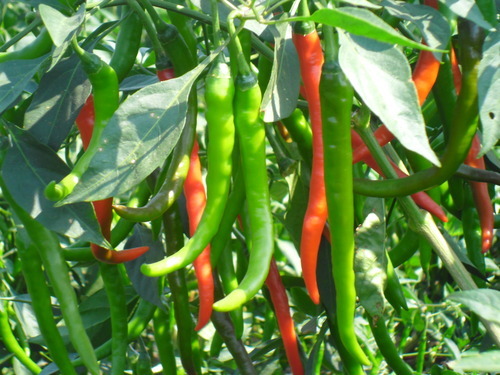
My Little Thumb
Chilly
(Capsicum annuam)
Chilly is considered a hardy cool-weather vegetable and can be planted in either the early spring or fall. Available in numerous varieties and shades, cabbage is abundant in vitamins C and E, beta-carotene and fiber. One of the keys to planting cabbage is to ensure the plants have slow, uninterrupted growth. Once you arm yourself with these tips on how to plant cabbage, you can be well on your way to enjoying the delicious vegetable.
| Recommended Bag | : | Large |
|---|---|---|
| Life Time | : | 8 Weeks |
| Seed | : | 15 per bag |
| Nutrients | : | Calories( 10% ), Carbohydrates( 10% ), Energy( 10% ), Fat( 10% ), Nitrates( 10% ), Other Vitamins( 10% ), Potassium ( 10% ), Protein( 10% ), Sodium( 10% ) |
| Fertilizers & Pesticides | : | Granular triple superphosphate, Phosphorus, Potassium, Potassium chloride, Urea, |
| Varieties | : | Bird's eye , Cascabel |
Plantation method
Hybrid Chilli Plant Cultivation
CULTIVATION TECHNIQUE
HYBRID SYSTEM chili plastic mulch
Today the farming systems of hybrid chili silver black plastic mulch (MPHP) widely practiced in the chili Hot Beauty, Hero, Long Chili, Ever-Flavor and chili peppers. It is also possible on the farm and hybrid chili pepper curly tiny (pepper, cengek) hybrids. The main reason MPHP system used in chili-pepper hybrids is to offset the cost of increasing the procurement MPHP chili peppers higher than usual, so it is economically advantageous. Cultivating hybrid chili with MPHP system is an improvement to the culture-intensive techniques. In general, cropping systems in chili pepper production centers are still using local seed and plant population per hectare is high. This dense population may lead to the capture of sunlight each plant is reduced and the air humidity is high around the garden. High humidity can often increase pest and disease attack. Improvement culture chili intensive cultivation techniques to improve production and quality of results, including the use of improved seed of hybrid varieties of high quality, implementation of MPHP, balanced fertilization, pest and disease control, as well as other ways like a typical installation of pillar and shoots perempelan or leaves. The main activities of chili cultivation techniques MPHP hybrid system include:
Preparation of Land
In the cultivation of hybrid chilli MPHP systems, land preparation should come first, followed by preparation of the seed or seedling. It means that the soil as a growing medium has really matured and worth planting. Conversely, when the seedlings come first, then the land preparation will be in a hurry, so that the land has not been cooked properly and seeds sudat old already. Hybrid chili seeds usually ready dipindahtanamkan from the nursery to the field (garden) at the age of 17-23 days (leaves 2-4 strands). When the seedlings late dipindahtanamkan (already old), less than optimal growth and production is decreased (low).
Land requirements for hybrid chili garden MPHP system are:
It was open to receive full sunlight.
Cropping land is not used sefamili, such as potatoes, tomatoes, eggplant taupun tobacco; to avoid the risk of disease.
The best land is a former rice paddy soil, so as not heavy enough to plow.
Moor land (dry land) can be used, provided that sufficient water is available.
CLIMATE AND SOIL
Climate Terms
In general, peppers can be planted in the lowlands to the mountains (the highlands) + 2000 meters above sea level which requires a climate not too cold and not too humid. A good temperature for pepper plants is 240-270 C, and for the formation of fruit in the range of 160-230 C. Each hybrid chilli varieties has its own power adjustment to the environment grows. Hot chili Beauty and Hero hybrids can produce well in the lowlands to the highlands of + 1200 m asl. While Long Chili peppers are more suitable hybrids planted at an altitude of between 800 - 1500 m asl. Especially for the chili peppers are generally suitable only grown in the highlands. The optimum temperature range for growth and development of sweet pepper between 210-250 C, while for-an-forming temperature of the fruit requires 18.30. Chili peppers are not resistant to high light intensity as it can cause the fruit, such as burning (sunburn) and also the final result will be very low weight of the fruit. In the unfavorable environmental conditions, plants will experience a fall shoot peppers, fall flowers and young fruit, and fruit size is very small. Although chili peppers are generally suitable planted in the highlands, but it can also be developed in plain medium starting height of 600 m above sea level; ie by way of manipulating the environment. Paprika cultivation technology transfer in the middle ground, among others, use a clear plastic roof lid (transparent).




